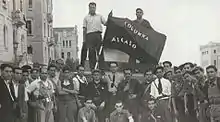Ascaso Column
The Ascaso Column was the third column organized in Barcelona at the beginning of the Spanish Civil War. They left for the Aragon front on July 25 with 2,000 militiamen. They had 4-6 machine guns and 3-4 trucks, transformed into armored tiznaos by a Gavà metallurgist.[1] It was located in the sector of Huesca, and was run by Cristóbal Alvaldetrecu, Gregorio Jover and Domingo Ascaso. Among the participants in the column was José Luis Facerías, later known as one of the libertarian maquis in Catalonia between 1945 and 1953. The internationalist groups "Giustizia e Libertá" and the "Battalion of Death" (Centuria Malatesta) also joined the Ascaso Column.
| Ascaso Column | |
|---|---|
| Columna Ascaso | |
 The Ascaso Column on the day they left for the front in Aragon | |
| Country | |
| Allegiance | |
| Branch | |
| Type | Militia |
| Role | Home defense |
| Size | 2,000 |
| Garrison/HQ | Huesca |
| Engagements | Spanish Civil War: Aragon front |
| Commanders | |
| Notable commanders | Cristóbal Alvaldetrecu, Gregorio Jover, Domingo Ascaso |
History
The column emerged from the Nosotros anarchist group and was named after Francisco Ascaso, an anarchist from Huesca who died in the fighting on July 20 in Barcelona. The column was led by Gregorio Jover and by Francisco's brother, Domingo Ascaso.
The Ascaso Column, reached Barbastro on July 27, where they met the remains of the Barbastro Regiment, about 350 men who had remained faithful to the Republic. This regiment was absorbed as part of the column. The siege operations at Huesca began in August, with the taking of Siétamo. The fight from here was intense, Huesca was surrounded by three columns, of about 7000 militiamen in total. This situation cast doubt on the loyalty of the Barbastro Regiment's commanders, much criticized both by the forces of the CNT and those of the POUM, only defended by the PSUC. The republican officers were transferred to Málaga and given command there, but after their defeat at the Battle of Málaga, they were also harshly attacked by the PSUC.
The column participated in different engangements, especially in the Huesca Offensive and in the battle of Monte Pelado. Some 1,200 Italians and 800 Spaniards participated in this, suffering great losses. They captured the position at Monte Pelado but this did not lead to the taking of Huesca.
International
The column became known for including groups of international fighters. Among them was an international group of German anarchists from the German Anarcho-syndicalist Group and German Marxists from the People's Olympiad, which together formed a century, commanded by Hans Beimler. Italian internationalists also participated in the column. The liberal republicans of the column formed Giustiza e Libertà, led by Carlo Rosselli and Fausco Falschi. The Italian anarchists, meanwhile, formed the so-called Battalion of Death (or Centuria Malatesta), made up of Italians exiled in France, they made a great impression on their parade through Barcelona, because of their paramilitary-looking black uniforms - emblazoned with the skull and crossbones.
The Battalion of Death was trained in a farmhouse in Sant Adrià de Besòs, equipped and financed by the Government of Catalonia at the request of Diego Abad de Santillán, and commanded by Camillo Berneri. They entered into battle on the wrong foot, being defeated in Almudévar and in Montalbán. In the assault on Santa Quiteria they were annihilated. The remains of the battalion rejoined the Ascaso Column and others crossed the French border. However, others, such as the Giustiza e Libertà internationalists, ended up in the Garibaldi Brigade of the International Brigades.[2]
Militarization
The Ascaso column, along with the Harriers and Red and Black columns, were regimented into the mixed brigades. Between the three they would total about 7,000 fighters.[3]
After militarization, the column became the 28th Division of the Spanish Republican Army, commanded by Gregorio Jover, who was in favor of militarization. Miguel García Vivancos, from the Aguiluchos column commanded the 125th Mixed Brigade, and Máximo Franco commanded the 127th.
This division participated in the Huesca Offensive. The following year they fought in the Battle of Teruel, moving on to the Alfambra area. When the Aragon front sank, the column moved to the central zone. In August 1938 they went to Extremadura, this time under the command of Andrés García La Calle. They participated in the Battle of Extremadura and in the Battle of Peñarroya.[4]
References
- http://www.vexicat.org/Semiotica_BI_1_Milicias_Populares.pdf
- Vicente Guarner. Catalonia in the Spanish War (Ed. G. del Toro)
- Michael Alpert. "The Republican Army in the Civil War." 21st century of Spain, 1989
- http://www.sbhac.net/Republica/Fuerzas/EPR/EprL/BM126.htm
Bibliography
- Albert Minning. For the good of the revolution. Alikornio editions. Barcelona 2005. ISBN 84-933205-1-X
- Antoine Giménez. Of Love, War and Revolution. Pumpkin Nuggets, 2009.
- Vicente Guarner. Catalonia in the Spanish War (Ed. G. del Toro)
- Martínez de Sas, María Teresa et al.: Biographical Dictionary of the Movement to Work in Catalan Countries , Ed. Publicacions de L'Abadia de Montserrat. ISBN 9788484152439